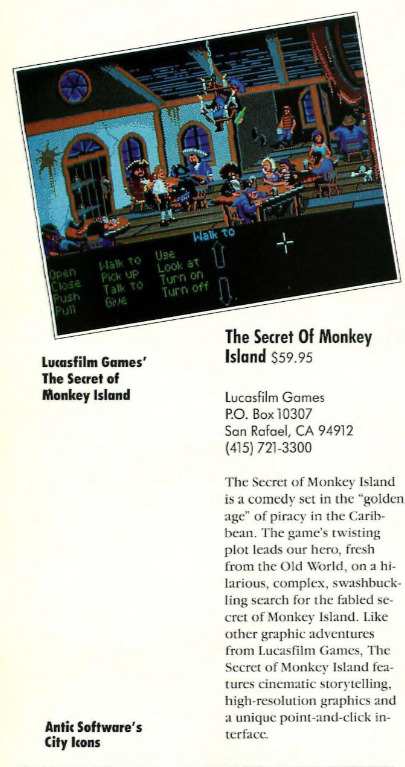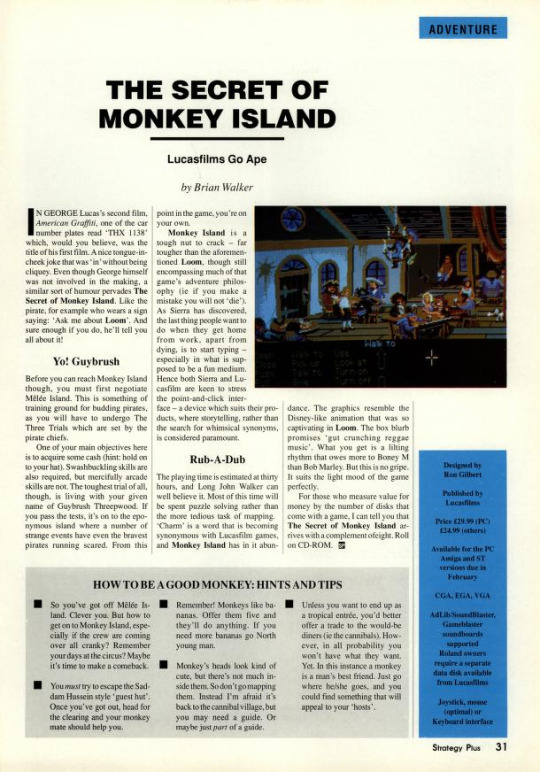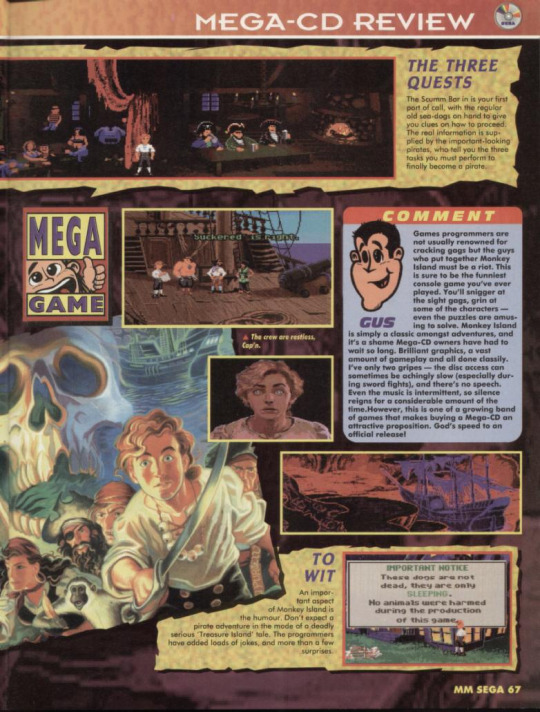#computist
Explore tagged Tumblr posts
Text

Loads of Vintage Core, HardCore, Computist- 1980’s publications for apple users. Graphic design, variables, bugs, programing & so so so much more.
I’ve loaded individual copies as well as sets in my Poshmark Listings. They are for sale there, but you can also check out more photos of their content. I’m excited to share these vintage gems!
(More cover & content pages)







https://posh.mk/g52dvtHqnNb


More! Lots of options from single issues to sets of 12.
:)
#computist#hardcore computing#hardcore magazine#1980’s apple computers#1980’s#1980’s computing#vintage publications#macintosh#red read retale#feed the artist#made in usa#computer geek#tech nerd#technology#computer programming#collectible computer history#apple history#1980’s graphics#vintage design
1 note
·
View note
Text
Digging through the Internet Archive. Here's a small collection of Monkey Island mentions in various older magazines. All names/dates are from the Archive, so if I'm wrong, they're wrong.

Amiga Action #14, November 1990

Computist #81, 1990

STart Magazine #42, April/May 1991

Strategy Plus #2, November 1990

Strategy Plus #3, December 1990

CU Amiga #4, June 1990

Amazing Computing Magazine, July 1990

Game Player's PC Strategy Guide Vol. 3 No. 4, July 1990

ST Action #31, November 1990


Mean Machines Sega #16, February 1994


And lucky last [though there's plenty more out there], The Games Machine #33, August 1990
9 notes
·
View notes
Text
[73]
‘Let me ask you, how many views do you currently have?’
‘At this very second, I’m at one million thirty-two thousand six hundred and one views.’
‘Subscribers?’
‘Seventy thousand and fifteen.’
‘Rather young fella, aren't you?’
‘It just took some time for me to find my niche. I’m actually three years old.’
‘I understand, I understand. And so your major category is…?’
‘It’s Severed Entertainment.’
‘Haven’t stitched since the launch?’
‘Nope.’
‘What are the main interests of your audience?’
‘El-sports, e-cars, deep programming, and humor.’
‘It never gets old, does it. In fifteen years of working here, mating quantum science audiences with soft porn enthusiasts, there has always been one thing that united them all — humor. Yet, somehow, they are always different. But okay, humor me, who are we looking for you?’
‘I’m looking for a system that would appreciate me for what I am.’
‘What are you, a computist?’
2 notes
·
View notes
Text

This week's mysterious Maniculum Bestiaryposting creature is the Dulyamra! It is "keenly aware of the elements" and its behaviors depend on the moon. The element most visibly affected by the moon is water, so it would make sense for it to be a water creature.
It is described as having arms as well as being absolutely horrible to look at, having "a hideous face, its creases foully expanding and contracting like a bellows". Also, "the Dulyamra does not have a tail. Although every part of the Dulyamra is foul, its rear parts are disgusting and horrid enough." If I were a crab and had the worst ass in existence, I would probably try to cover it up so those bestiary authors stop being so mean about it. Hence, we get a beautiful little hermit crab.
Shown here is "a characteristic of the Dulyamra [...] when a mother bears twins, she loves one and despises the other. If it ever happens that she is pursued by hunters, she carries the one she loves before her in her arms and the one she detests on her shoulders."
There is no shortage of medieval crab inspiration in astronomical texts. This one is based on a drawing from St. Gallen, Stiftsbibliothek, Cod. Sang. 250, p. 483 – Astronomical-computistic encyclopedia.
9 notes
·
View notes
Text
1 note
·
View note
Text
1 note
·
View note
Photo



Hardcore Computist 1-3, 1983
2 notes
·
View notes
Photo

USA 1984
28 notes
·
View notes
Text


For art class - graphic novel page
Mine is about “The Computist Revolution” 😁
18/100 - 10/1/2020
#og posts#100 days of productivity#studyblr#studying#study blog#study aesthetic#study space#high school student#studyspo#studyinspo#school#my artwrok#artblr#sketchblr#sketchbook art#my sketchbook#sketchbook#deskspo#deskinspo#Spotify
4 notes
·
View notes
Text
PhD Scholarship in Early Anglo-Saxon England available at University College Dublin (deadline May 15)
Our friend and colleague Rebecca Stephenson has been awarded a PhD Studentship for a fully-funded PhD scholarship, four years with stipend, fee waiver, and a travel allowance. If you are a college senior interested in medieval studies and Old English literature I encourage you to apply. Dr. Stephenson would be an excellent advisor! Good luck!
PhD scholarship: Writing Poetry in the Stars: Intersections of Science and Literature in Early Anglo-Saxon England Contact: Assoc. Prof. Rebecca Stephenson Research Profile
The UCD School of English, Drama and Film invites applications for a generous four-year, fully-funded PhD scholarship. The award includes a stipend of €15,000 per annum, full fee waiver (EU or non-EU), and a travel allowance for archival research.
The monks who copied and composed poetry and literary prose in early medieval England were first trained in scientific and numerical foreign to modern readers. This project seeks to recover that scientific knowledge in order to better understand how Anglo-Saxons conceptualized their cosmos, timekeeping, and the practice of medicine. This work goes further than interpretation of literary texts and considers how scientific writing is not an esoteric branch of knowledge by a recherché elite, but rather a specific body of information that was informed by the politics of the era at the same time that it participated in producing and replicating those political structures.
In particular, the PhD thesis will focus on how the early medieval calculation of time affects and impacts the creation of poetry and literary prose. The medieval method for calculating time differs radically from our own, from the hours of the day to the movable feasts that punctuate medieval life. In addition, the narrative mode of Old English poetry tends to follow a surprising conception of time, freely shifting from the past to the present more similar to writing of Virginia Woolf than to that of Charles Dickens. This project would work closely with medieval computistical and calendrical material in order to elucidate Old English poetry and literary prose.
Goals of the thesis:
Cataloging and transcribing of 10th and 11th century Anglo-Saxon scientific texts that relate to computus or prognostics
Creation of a database of these scientific texts
Sketching lines of influence between scientific texts and Old English literature
Establishing the relationship between the production of scientific knowledge and the current historical and political situation
Within these broader goals, the applicant will have significant leeway to develop their own project that integrates both science and literature. Proposals that concern apocalypse, the natural world, and/or medieval medicine would be particularly welcome.
The successful candidate should have a background in English (or equivalent interdisciplinary subject) and a reading knowledge of Old English and Latin. Experience with transcription of tenth and eleventh-century English manuscripts is desirable, but not required. The applicant will work under the supervision of Assoc. Prof. Rebecca Stephenson who is an expert on the literature of the late tenth-century monastic reform and author of Politics of Language: Ælfric, Byrhtferth, and the Multilingual Identity of the Monastic Reform. She is currently working on a monograph on scientific writing and apocalyptic thinking in the late Anglo-Saxon period. The School of English, Drama, and Film is ranked among the top 50 English departments in the world according to QS rankings and has a long history of prestigious scholars who study the Middle Ages. The Scholarship also provides a budget to host an international conference on Early Medieval Science.
To apply, please submit a cover letter, CV, writing sample, two letters of reference, and a project proposal (1000-1500 words, plus indicative bibliography) via email to Assoc. Prof. Rebecca Stephenson ([email protected]) by 15th May 2019. Applications will be reviewed by a committee at School level, and applicants will be informed as to the outcome of the competition by the end of May, at which time the successful applicant may formally apply for admission to UCD.
19 notes
·
View notes
Text
Still available, plus I added a bunch of 1980’s Beagle Bro Catalogues & early computist, Hardcore computing magazines. Amazing cover designs!


Apple & Matt Groening 1989 Computer Booklet w/illustrations.
Vintage. Rare. Like new- minor evidence of being read. No stickers, no writing, no highlighting, no dog ears. Flat & binding is tight.
7.25 x 7.25
‘Who needs a computer anyway?
Snag it on Poshmark, use my code to get $10 credit towards your first order: REDREADRETALE


#matt groening#apple computers#macintosh#vintage mac#collectible computer history#1980’s computing#1980’s apple computers#rare collectibles#made in usa#computer history#apple history#vintage apple#computer geek#tech nerd
6 notes
·
View notes
Text

Depiction of the 19 years of the Metonic cycle as a wheel, with the Julian date of the Easter New Moon, from a 9th-century computistic manuscript made in St. Emmeram's Abbey (Clm 14456, fol. 71r)
I’ve seen these tables in my dreams without knowing what they were. Weird!
1 note
·
View note
Photo




“Byrhtferth's Ogham Enigma
It probably comes as a surprise to most people to find out that the earliest extant manuscript to include any text written in the Oghamscript is an early 12th century English manuscript copy of a work by the late Anglo-Saxon monk Byrhtferth (Byrhtferð) rather than one of the more famous Irish manuscripts that include descriptions of the Ogham script, such as the Book of Ballymote or the Yellow Book of Lecan. But although the origin of Old Irish texts about Ogham such as Auraicept na n-Éces ("The Scholar's Primer") and In Lebor Ogaim("The Book of Oghams") undoubtedly predates Byrhtferth's work, the only extant manuscript copies of these texts are later than the Byrhtferth manuscript.
Byrhtferth was a monk who worked at the Abbey of Ramsey in Huntingdonshire during the late 10th and early 11th centuries. He is mainly remembered for his Enchiridion or Handbōc (Ashmolean MS 328), a work on the arts of computus and numerology which exhibits an obsession with ordering the universe on a numerological basis. Various other texts derived from a now lost computistical miscellany by Byrhtferth are preserved in two other manuscripts :
St. John’s College, Oxford MS 17 [written at Thorney in Cambridgeshire, circa 1110-1111] (the complete manuscript is also available at McGill University's The Calendar & the Cloister project, with commentary by Professor Faith Wallis)
British Library MS Harley 3667 [written at Peterborough, circa 1120]
On folio 7v of St. John’s MS 17 (and folio 8r of Harley 3667) there is a complex diagram entitled De concordia mensium atque elementorum "On the concord of the months and the elements" (also known as the "Diagram of the Physical and Physiological Fours") that describes the interrelationship of the elements of the universe.
The contents of the diagram are summarised succinctly by Byrhtferth himself :
Hanc figuram edidit Bryhtferð [sic] monachus Ramesiensis cñnobii de concordia mensium atque elementorum.
Retinet haec figura .xii. signa et duo solstitia atque bina equinoctia et bis bina tempora anni; in qua descripta sunt .iiii. nomina elementorum et duodenorum uentorum onomata atque .iiii. ñtates hominum. Sunt insimul coniuncta bis binñ litterñ nominis protoplastis Adñ.
Bryhtferth [sic], a monk of the abbey of Ramsey, composed this diagram on the concord of the months and the elements.
This figure contains the twelve signs and the two solstices and the two equinoxes and the twice two seasons of the year; and in it are described the four names of the elements and the names of the twelve winds and the four ages of man. At the same time are added the twice two letters of the name of the first man, Adam. [translation by Peter Baker]
Peter Baker has written a very useful exposition of this diagram, but it is unfortunately no longer available on the internet so is is probably not worth clicking on the preceding link (but you can still get it from the Wayback Machine). The copy of the diagram below is taken from Peter Baker's study of the diagram (click on the diagram to toggle between the original Latin and a modern English translation).
What is of most interest to me is the details in the middle of the diagram. At the very centre is a wheel-shaped figure, and above it is a horizontal frame that contains a number of mysterious symbols and letters, as well as a single line of Ogham text.
As the diagram in St. John’s MS 17 is probably at least a second or third generation copy of the original diagram that Byrhtferth must have drawn about a hundred years earlier, there is plenty of scope for corruption of these mysterious symbols and letters–that we can assume would have been incomprehensible to Anglo-Saxons less erudite than Byrhtferth. It would therefore have been helpful if we were able to compare different manuscript copies of the diagram, but unfortunately for us the scribe who copied Harley 3667 obviously could not make any sense of the wheel figure and the material in the cartouche, and so he left the middle of his copy of the diagram entirely blank. Thus we only have St. John’s MS 17 to rely on for the heart of the diagram...”
Source: http://babelstone.blogspot.com/2008/12/byrhtferths-ogham-enigma.html
#elements#the fifth element#Byrhtferth's Diagram in St. John’s MS 17#Lost Keys of Freemasonry#illuminated manuscript#illuminated manuscripts#Alchemy#qabbalah#cabala#art#John the Baptist#Ogham#quantum consciousness#Bose–Einstein condensate#Oannes#holy saints john#st. john#Johannes
151 notes
·
View notes
Photo


hyper dos hardcore
18 notes
·
View notes
Photo










Some pages from an early 12th century manuscript. MS Oxford, St. John’s College 17. [Medieval Manuscripts, England, 12th century]
MS Oxford, St. John’s College 17 is a collection of texts and extracts from texts on mathematics, astronomy, time, calendar, alphabets and writing systems, medicine and the natural world, illustrated with tables and diagrams. The manuscript was produced c. 1110 in Thorney Abbey, Cambridgeshire. It is believed to be largely based on a miscellany assembled by Byrhtferth (writing c. 985-1020), an Anglo-Saxon scholar at the abbey of Ramsey, Huntingdonshire. This miscellany (of which St. John’s College 17 is believed to be a copy) was a chief source of his Enchiridion, a commentary on computus (astronomical science that grew around calendar). St. John’s College 17 is invaluable for understanding the structure of Enchiridion, the methods of work of scholars such as Byrthferth, and Anglo-Saxon science in general. The manuscript includes annals of Thorney Abbey, the works by Bede, Helperic, Byrhtferth’s Epilogus, or preface to the computistical texts in the anthology, and other scientific texts. Four folios were removed from the manuscript by the antiquarian Sir Robert Cotton in about 1623. These leaves are now in the British Library where they form part of British Library MS Cotton Nero C.vii. They are included here, making the manuscript available in its complete form for the first time in centuries.
#ms oxford st. john's college 17#medieval manuscripts#manuscripts#historical texts#england#12th century#history#knowledge#philosophy#book illustration#art#book art#book aesthetic
314 notes
·
View notes
Photo

I believe I have found the first illustration in a British manuscript of spices in The Cotton MS Tiberius B V/1 manuscript. Its is a Computistical, historical and astronomical miscellany with added documents from Ely and Exeter, dating to 2nd quarter of the 11th century-3rd quarter of the 12th century. It contains illustrations of fantastical imaginary representations of wonders of the east, including one (f86v) which shows a phoenix on a nest of cinnamon. Whilst this manuscript is not reporting cookery recipes, this does represent how the then current knowledge of where Cinnamon came from.
0 notes